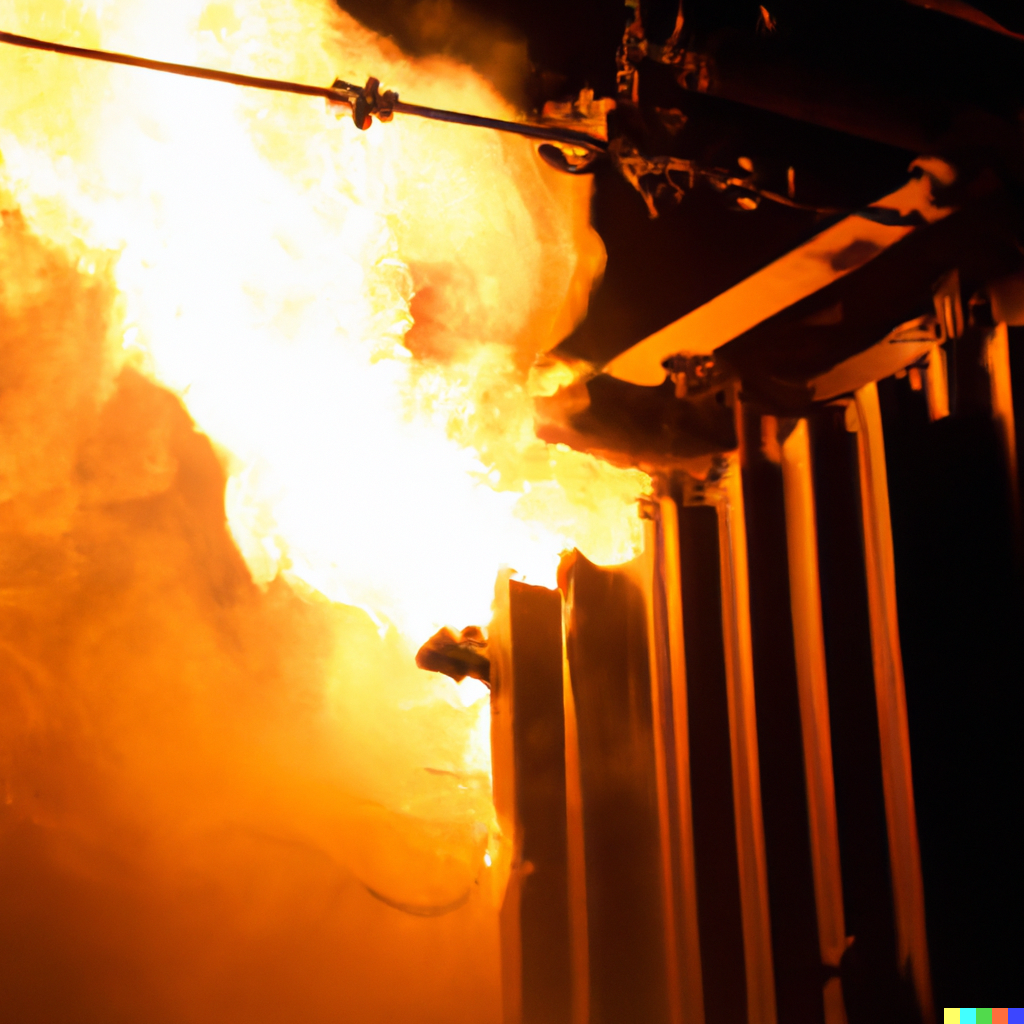Table of Contents
Common Causes of Transformer Failure
Transformers are an essential component of the power grid that converts electrical energy from one voltage level to another.
Transformers are designed to last for decades, but they can fail prematurely due to several reasons. Here are some of the common causes of transformer failure.
Overheating

Overheating is one of the most common causes of transformer failure. When a transformer is overloaded or operated in high temperatures for an extended period, it can cause insulation breakdown, leading to a short circuit.
This can cause the transformer to fail or even catch fire. Check out my in-depth article on What Causes The Transformer to Overheat.
Insulation Failure
Transformer insulation is designed to withstand high voltages and protect the transformer from electrical faults.
However, insulation can fail due to several reasons, such as aging, moisture, chemical contamination, or mechanical damage. Insulation failure can lead to arcing, which can damage the transformer and cause it to fail.
Want to learn more about why transformer insulation fail and how to prevent it? Check out my in-depth article on the subject to keep your equipment running smoothly and avoid costly repairs. Click here to read our article on transformer insulation failure causes and how to prevent it.
Electrical Stress
Transformers are subjected to electrical stress during operation, which can cause insulation breakdown and arcing.
Electrical stress can occur due to voltage surges, lightning strikes, switching surges, or other electrical disturbances.
These events can cause high currents to flow through the transformer, leading to thermal and mechanical stresses that can cause it to fail.
Mechanical Stress
Mechanical stress can occur due to various reasons, such as vibration, shock, or inadequate support.
Mechanical stress can cause winding deformation, insulation damage, or even mechanical failure.
Transformers should be installed in a secure and stable location to minimize mechanical stress.
Contamination
Contamination such as moisture, dust, or chemical pollutants can cause transformer failure. Moisture can cause insulation breakdown and corrosion, while dust and other pollutants can cause arcing and short circuits.
Transformers should be installed in a clean and dry environment to minimize the effects of contamination.
Signs of a Failing Transformer
A failing transformer can cause several warning signs that can indicate a problem. Here are some of the common signs of a failing transformer.
Overheating
Overheating is one of the common signs of a failing transformer. If you notice a burning smell or excessive heat coming from the transformer, it may indicate an issue.
Noise
A failing transformer can produce a humming or buzzing sound, which may be due to mechanical or electrical issues.
Power Outages
Power outages or fluctuations can be a sign of a failing transformer. If you notice that your electrical devices are not working correctly, it may indicate a transformer issue.
Leaking Oil
Transformers use oil for cooling and insulation. If you notice oil leaking from the transformer, it may indicate a mechanical issue or a failure in the insulation.
Preventing Transformer Failure
Transformer failure can be costly and disruptive. Here are some steps you can take to prevent transformer failure.
Regular Maintenance
Regular maintenance can help detect and prevent transformer issues before they become severe.
Routine inspections, cleaning, and testing can help identify and address potential problems.
Regular maintenance is a critical aspect of ensuring the optimal performance of transformers and preventing failure.
Here are some of the essential maintenance tasks that can help keep your transformer in good condition:
- Inspection: Regular inspection of transformers is crucial to identify issues early on. Visual inspections can reveal issues such as corrosion, leaks, or other signs of damage. Additionally, electrical testing can help detect issues such as insulation degradation or winding faults.
- Cleaning: Keeping transformers clean can help prevent contamination and maintain optimal heat transfer. Transformers should be cleaned regularly to remove dirt, dust, and other debris.
- Oil Analysis: Transformers use oil for cooling and insulation, and the condition of the oil can affect transformer performance. Regular oil analysis can help detect issues such as contamination, degradation, or moisture.
- Repairs: Any identified issues during inspections or testing should be addressed promptly. Repairs can include rewinding, replacing faulty components, or repairing mechanical damage.
By performing regular maintenance tasks, you can help ensure that your transformer operates reliably and efficiently for its expected lifespan.
Additionally, routine maintenance can help prevent costly failures and downtime, leading to cost savings and improved reliability.
Load Management
Load management refers to the process of managing the electrical load that a transformer is subjected to.
Transformers are designed to operate within their rated capacity, which is the maximum load that the transformer can handle without being damaged.
When a transformer is subjected to a load greater than its rated capacity, it can overheat, leading to insulation degradation, winding damage, and other issues that can result in transformer failure.
To prevent overloading and ensure that the transformer operates within its rated capacity, it’s important to implement proper load management practices. Here are some of the key considerations for load management:
- Load Analysis: Understanding the electrical load that a transformer is subjected to is a critical first step in load management. Conducting load analysis can help identify peak load periods and load variations.
- Load Balancing: Proper load balancing can help distribute the electrical load evenly across multiple transformers. This can help prevent overloading of individual transformers and reduce the risk of failure.
- Load Shedding: Load shedding involves temporarily reducing the electrical load during periods of high demand. This can help prevent overloading and ensure that the transformer operates within its rated capacity.
- Power Factor Correction: Improving the power factor can help reduce the electrical load on transformers. This can be achieved through the use of power factor correction equipment, which can help reduce energy consumption and prevent overloading.
- Load Monitoring: Regular monitoring of the electrical load can help identify potential issues and prevent overloading. This can be achieved through the use of load monitoring equipment, which can provide real-time data on the electrical load.
Proper load management is an important aspect of preventing transformer failure. By implementing load management practices, you can help ensure that the transformer operates within its rated capacity and minimize the risk of failure due to overloading.
Protection Systems
Protection systems play a critical role in preventing transformer failure by protecting the transformer from electrical disturbances.
Here are some of the key protection systems that can help prevent transformer failure:
- Fuses: Fuses are devices that provide protection against short-circuits and overloads. When a fault occurs, the fuse will melt and break the electrical circuit, protecting the transformer from damage.
- Circuit Breakers: Circuit breakers are similar to fuses in that they provide protection against short-circuits and overloads. However, circuit breakers can be reset after tripping, making them more convenient for protection against temporary faults.
- Surge Protectors: Surge protectors are devices that protect against voltage surges and spikes. These devices can be used to protect the transformer from damage due to lightning strikes, power surges, and other electrical disturbances.
- Protective Relays: Protective relays are devices that detect abnormal operating conditions and activate protection systems to prevent transformer failure. These devices can detect issues such as overcurrent, overvoltage, and underfrequency, and activate protection systems to prevent damage.
- Ground Fault Protection: Ground fault protection is designed to protect the transformer from damage due to ground faults. Ground faults occur when an electrical current finds a path to the ground, potentially causing damage to the transformer. Ground fault protection can detect these faults and activate protection systems to prevent damage.
Implementing protection systems can help prevent transformer failure and ensure reliable operation.
By providing protection against short-circuits, overloads, surges, and other electrical disturbances, protection systems can help minimize the risk of damage to the transformer and prevent costly downtime and repair costs.
Proper Installation
Proper installation is critical for preventing transformer failure. The following are some key considerations for proper installation:
- Location: Transformers should be installed in a secure and stable location to minimize mechanical stress. The location should also be free from potential sources of contamination, such as dust, dirt, and moisture.
- Mounting: The transformer should be mounted securely and level to ensure proper alignment of the winding and core. The mounting structure should also be strong enough to support the weight of the transformer.
- Foundation: The transformer should be installed on a solid foundation to prevent vibration and mechanical stress. The foundation should be level, free from debris, and large enough to support the transformer.
- Ventilation: Proper ventilation is critical for maintaining the operating temperature of the transformer. The installation location should provide adequate ventilation, and the transformer should be positioned to allow for proper air flow.
- Connections: Proper connections are essential for ensuring reliable operation of the transformer. Connections should be made using appropriate connectors and properly tightened to prevent loosening.
- Grounding: Proper grounding is important for protecting the transformer from electrical damage. The installation location should provide a proper grounding point, and the transformer should be properly grounded according to local codes and standards.
By following proper installation practices, you can help minimize mechanical stress and contamination and ensure reliable operation of the transformer.
Proper installation can also help extend the lifespan of the transformer and prevent costly downtime and repairs.
Conclusion
Preventing transformer failure can be achieved through regular maintenance, load management, protection systems, and proper installation.
By taking these steps, you can help ensure that your transformer operates reliably and efficiently for years to come.
In conclusion, understanding the common causes of transformer failure and being aware of the warning signs can help you take proactive steps to prevent costly and disruptive failures.
By investing in regular maintenance, load management, and protection systems, you can help ensure that your transformer remains a reliable and essential part of the power grid.
With these strategies in mind, you can keep your power flowing smoothly and minimize downtime and repair costs.
Don’t Leave Empty-Handed!
Install my Free Android App on Google Play:
Electrical Cables Most Common Tables “Cables Tables”
And, my Electrical Calculations App “Fast Electrical Calculator”
Discover more great content by subscribing to My channel
Looking to stay ahead of the game in the world of electrical engineering? Subscribe to my YouTube channel and gain access to exclusive content you won’t find anywhere else!
The staff I recommend
(Amazon Affiliate Links to products I believe are high quality):
- Economy 120 Volt/60Hz AC Power Source – Step-Down Voltage & Frequency Converters 1800W
- UNI-T Digital Multimeter Tester UT139C
- 50-Amp Extension Cord for RV “100ft”
- Voltage Stabilizer 110/220v
- Hair Dryer “best selling“
- TOSHIBA EM131A5C-BS Countertop Microwave Ovens
Disclaimer: This contains affiliate links to Amazon products. I may earn a commission for purchases made through these links.

